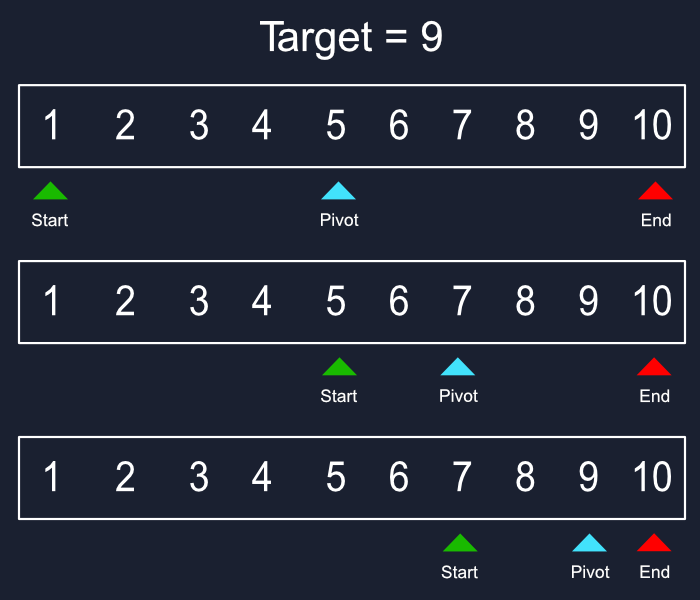- Log in to:
- Community
- DigitalOcean
- Sign up for:
- Community
- DigitalOcean

JavaScript comes with some pretty handy out-of-the-box tools for searching through an array. But with a large data set the O(n) methods like indexOf, find, or a basic loop just aren’t the best or even feasible. Instead, we can use Binary search to go over an array without looking at what we obviously don’t need, giving us a O(logn) solution.
Prerequisites
I will be using Big O Notation when comparing performance and complexity, which you can brush up on here.
Practice Data
Here are some sorted and unsorted datasets, both with 50 items, that I’ll be referencing.
const unsortedArr = [31, 27, 28, 42, 13, 8, 11, 30, 17, 41, 15, 43, 1, 36, 9, 16, 20, 35, 48, 37, 7, 26, 34, 21, 22, 6, 29, 32, 49, 10, 12, 19, 24, 38, 5, 14, 44, 40, 3, 50, 46, 25, 18, 33, 47, 4, 45, 39, 23, 2];
const sortedArr = [1, 2, 3, 4, 5, 6, 7, 8, 9, 10, 11, 12, 13, 14, 15, 16, 17, 18, 19, 20, 21, 22, 23, 24, 25, 26, 27, 28, 29, 30, 31, 32, 33, 34, 35, 36, 37, 38, 39, 40, 41, 42, 43, 44, 45, 46, 47, 48, 49, 50];
Linear Search
This is the standard brute-force solution I’m sure you’ve already done a thousand times. We’re just telling it, “I need something, so look through everything one-by-one until you find it”. If there’s a million times more items, it’ll take a million times longer, which nobody is going to put up with. Whether the data is sorted or not makes no difference.
const linear = (arr, target) => {
let steps = 0;
for (let i = 0; i < arr.length; i++) {
steps++;
if (arr[i] === target) return `Found: ${arr[i]} in ${steps} steps`;
};
};
console.log(linear(unsortedArr, 40)); // 40 steps in 40 Milliseconds
console.log(linear(sortedArr, 40)); // 40 steps in 40 Milliseconds
Binary Search
Brute-forcing your way to a result is obviously a very slow and unscalable solution. Instead of wasting resources looking at data that’s obviously not what we want, we can use a ‘divide-and-conquer’ approach to make each operation focus on ignoring what we don’t want instead of painfully looking for what we do want.
We have three main components, two pointers and one pivot. Each pointer starts at the either end of the array with the pivot in the center. Then we check if what we want is higher or lower than our pivot, if higher then the left pointer is moved to the pivot’s position while the pivot moved to the new middle. We keep running this until our pivot is equal to our target.

With each step we are cutting our data set in half, completely ignoring what we don’t need, giving us a time complexity of O(logn). If we ran a search for a number in an array of a million items that took ten steps, a billion item search may only take 15-20 steps.
const binary = (arr, target) => {
let start = 0;
let end = arr.length;
let pivot = Math.floor((start + end) / 2);
let steps = 0;
for (let i = 0; i < arr.length; i++) {
if (arr[pivot] !== target) {
if (target < arr[pivot]) end = pivot;
else start = pivot;
pivot = Math.floor((start + end) / 2);
steps++;
};
if (arr[pivot] === target) return `Found: ${target} in ${steps} steps`;
};
return 'Nothing Found';
};
console.log(linear(unsortedArr, 40)); // Nothing Found
console.log(binary(arr, 44)); // 5 steps in 8 Milliseconds
console.log(binary(arr, 43)); // 2 steps in 7 Milliseconds
Binary search comes with the big drawback of only allowing us to do this on sorted arrays, but there are other solutions based around pre-sorting your data before a search.
Conclusion
This is only one way of applying a binary search but the idea can be reconfigured for various data structures, as long as it’s sorted. In the future, I hope we can explore using this technique for traversing more advanced datasets at lightning fast speeds ⚡.
Thanks for learning with the DigitalOcean Community. Check out our offerings for compute, storage, networking, and managed databases.
About the author
Still looking for an answer?
This textbox defaults to using Markdown to format your answer.
You can type !ref in this text area to quickly search our full set of tutorials, documentation & marketplace offerings and insert the link!
- Table of contents
- Prerequisites
- Practice Data
- Linear Search
- Binary Search
- Conclusion
Deploy on DigitalOcean
Click below to sign up for DigitalOcean's virtual machines, Databases, and AIML products.
Become a contributor for community
Get paid to write technical tutorials and select a tech-focused charity to receive a matching donation.
DigitalOcean Documentation
Full documentation for every DigitalOcean product.
Resources for startups and SMBs
The Wave has everything you need to know about building a business, from raising funding to marketing your product.
Get our newsletter
Stay up to date by signing up for DigitalOcean’s Infrastructure as a Newsletter.
New accounts only. By submitting your email you agree to our Privacy Policy
The developer cloud
Scale up as you grow — whether you're running one virtual machine or ten thousand.
Get started for free
Sign up and get $200 in credit for your first 60 days with DigitalOcean.*
*This promotional offer applies to new accounts only.
